An Analysis of Tesco's Supply Chain and Logistics Management System
VerifiedAdded on 2022/08/26
|11
|3128
|16
Report
AI Summary
This report provides a comprehensive analysis of Tesco's supply chain and logistics management. It begins with background information and market outlook of Tesco, followed by an in-depth examination of its supply chain and logistics management system, including supplier, manufacturer, and distributor integration. The report identifies challenges in implementing supply chain management, such as operational inefficiencies, response to trends, quality and regulatory compliance, online competition, and employee-related issues. It then evaluates the role of Radio-Frequency Identification (RFID) technology in enhancing inventory visibility and efficiency. The report concludes by discussing how Tesco embeds sustainable (green) logistics within its forward and reverse supply chains, addressing aspects related to suppliers, manufacturers, distributors, and consumers. This analysis provides insights into Tesco's strategies for optimizing its supply chain, addressing challenges, and promoting sustainability.
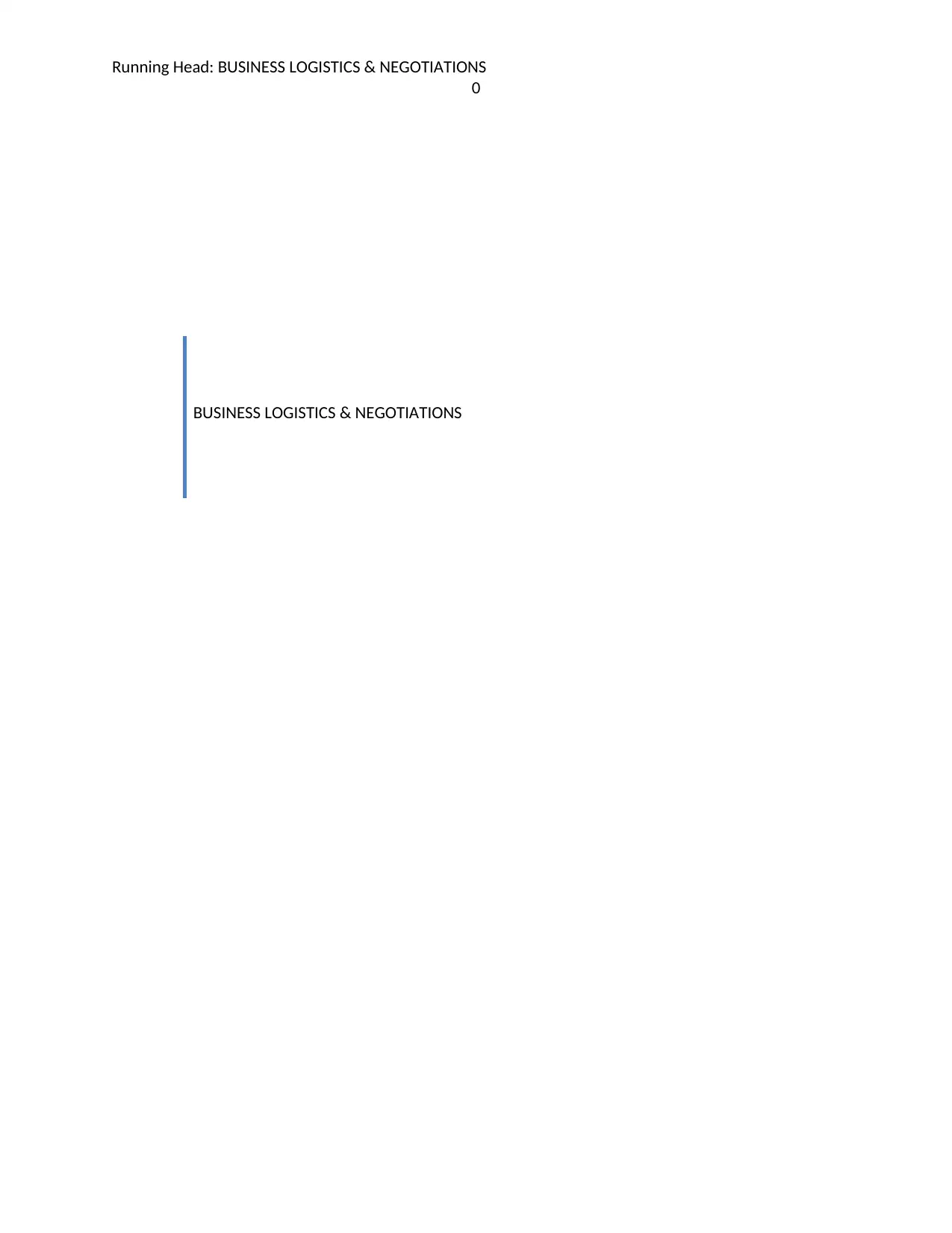
Running Head: BUSINESS LOGISTICS & NEGOTIATIONS
0
BUSINESS LOGISTICS & NEGOTIATIONS
0
BUSINESS LOGISTICS & NEGOTIATIONS
Paraphrase This Document
Need a fresh take? Get an instant paraphrase of this document with our AI Paraphraser
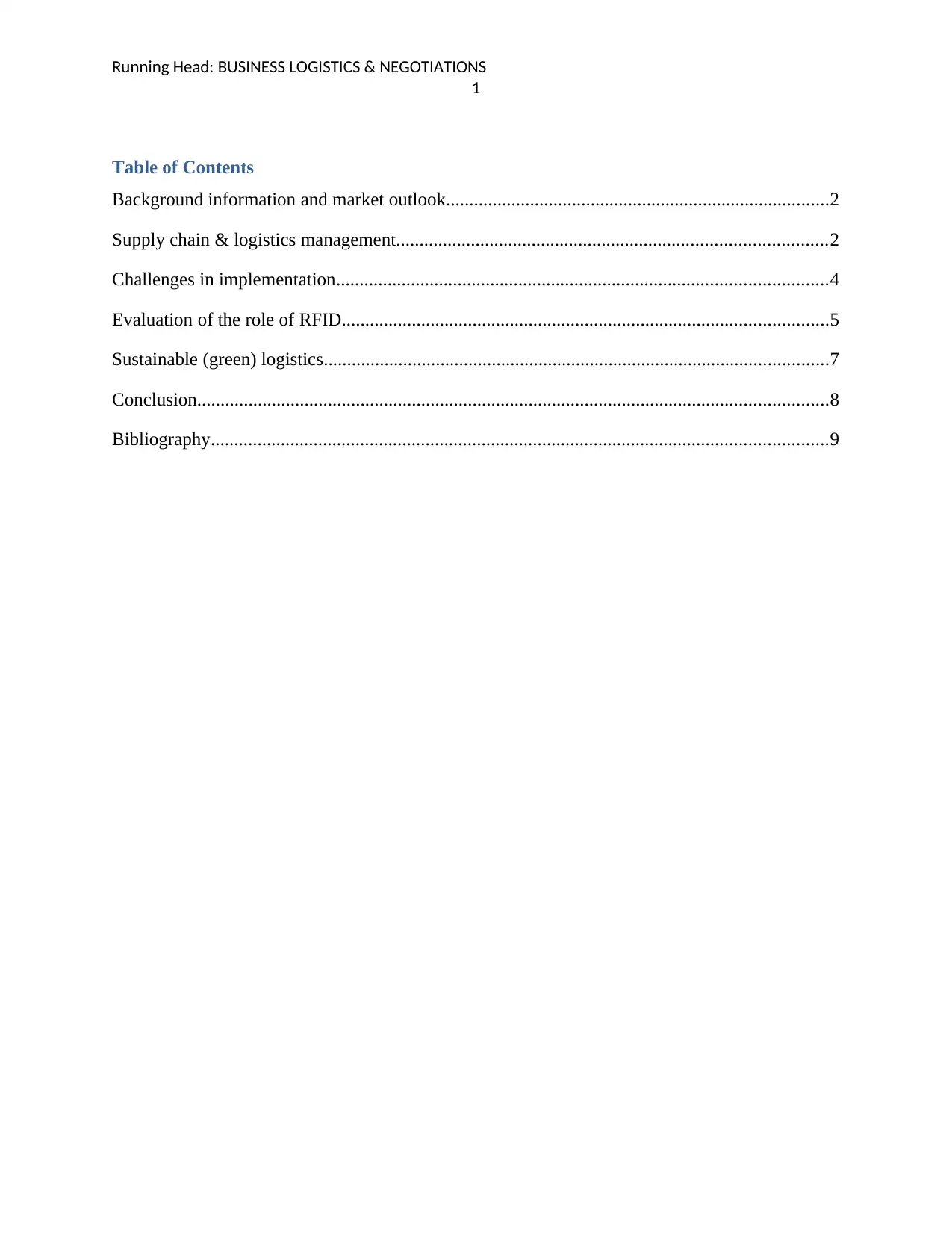
Running Head: BUSINESS LOGISTICS & NEGOTIATIONS
1
Table of Contents
Background information and market outlook..................................................................................2
Supply chain & logistics management............................................................................................2
Challenges in implementation.........................................................................................................4
Evaluation of the role of RFID........................................................................................................5
Sustainable (green) logistics............................................................................................................7
Conclusion.......................................................................................................................................8
Bibliography....................................................................................................................................9
1
Table of Contents
Background information and market outlook..................................................................................2
Supply chain & logistics management............................................................................................2
Challenges in implementation.........................................................................................................4
Evaluation of the role of RFID........................................................................................................5
Sustainable (green) logistics............................................................................................................7
Conclusion.......................................................................................................................................8
Bibliography....................................................................................................................................9
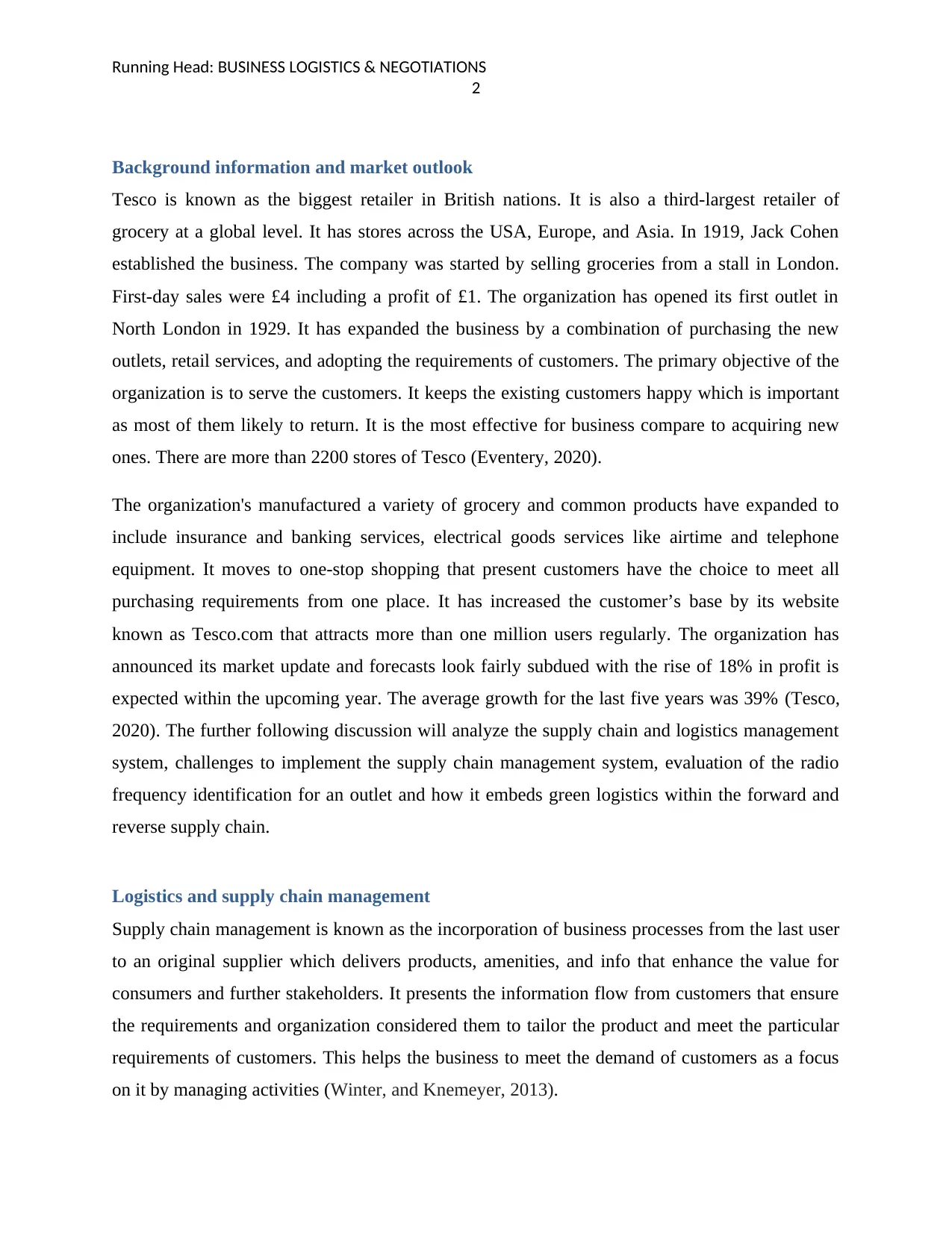
Running Head: BUSINESS LOGISTICS & NEGOTIATIONS
2
Background information and market outlook
Tesco is known as the biggest retailer in British nations. It is also a third-largest retailer of
grocery at a global level. It has stores across the USA, Europe, and Asia. In 1919, Jack Cohen
established the business. The company was started by selling groceries from a stall in London.
First-day sales were £4 including a profit of £1. The organization has opened its first outlet in
North London in 1929. It has expanded the business by a combination of purchasing the new
outlets, retail services, and adopting the requirements of customers. The primary objective of the
organization is to serve the customers. It keeps the existing customers happy which is important
as most of them likely to return. It is the most effective for business compare to acquiring new
ones. There are more than 2200 stores of Tesco (Eventery, 2020).
The organization's manufactured a variety of grocery and common products have expanded to
include insurance and banking services, electrical goods services like airtime and telephone
equipment. It moves to one-stop shopping that present customers have the choice to meet all
purchasing requirements from one place. It has increased the customer’s base by its website
known as Tesco.com that attracts more than one million users regularly. The organization has
announced its market update and forecasts look fairly subdued with the rise of 18% in profit is
expected within the upcoming year. The average growth for the last five years was 39% (Tesco,
2020). The further following discussion will analyze the supply chain and logistics management
system, challenges to implement the supply chain management system, evaluation of the radio
frequency identification for an outlet and how it embeds green logistics within the forward and
reverse supply chain.
Logistics and supply chain management
Supply chain management is known as the incorporation of business processes from the last user
to an original supplier which delivers products, amenities, and info that enhance the value for
consumers and further stakeholders. It presents the information flow from customers that ensure
the requirements and organization considered them to tailor the product and meet the particular
requirements of customers. This helps the business to meet the demand of customers as a focus
on it by managing activities (Winter, and Knemeyer, 2013).
2
Background information and market outlook
Tesco is known as the biggest retailer in British nations. It is also a third-largest retailer of
grocery at a global level. It has stores across the USA, Europe, and Asia. In 1919, Jack Cohen
established the business. The company was started by selling groceries from a stall in London.
First-day sales were £4 including a profit of £1. The organization has opened its first outlet in
North London in 1929. It has expanded the business by a combination of purchasing the new
outlets, retail services, and adopting the requirements of customers. The primary objective of the
organization is to serve the customers. It keeps the existing customers happy which is important
as most of them likely to return. It is the most effective for business compare to acquiring new
ones. There are more than 2200 stores of Tesco (Eventery, 2020).
The organization's manufactured a variety of grocery and common products have expanded to
include insurance and banking services, electrical goods services like airtime and telephone
equipment. It moves to one-stop shopping that present customers have the choice to meet all
purchasing requirements from one place. It has increased the customer’s base by its website
known as Tesco.com that attracts more than one million users regularly. The organization has
announced its market update and forecasts look fairly subdued with the rise of 18% in profit is
expected within the upcoming year. The average growth for the last five years was 39% (Tesco,
2020). The further following discussion will analyze the supply chain and logistics management
system, challenges to implement the supply chain management system, evaluation of the radio
frequency identification for an outlet and how it embeds green logistics within the forward and
reverse supply chain.
Logistics and supply chain management
Supply chain management is known as the incorporation of business processes from the last user
to an original supplier which delivers products, amenities, and info that enhance the value for
consumers and further stakeholders. It presents the information flow from customers that ensure
the requirements and organization considered them to tailor the product and meet the particular
requirements of customers. This helps the business to meet the demand of customers as a focus
on it by managing activities (Winter, and Knemeyer, 2013).
⊘ This is a preview!⊘
Do you want full access?
Subscribe today to unlock all pages.

Trusted by 1+ million students worldwide
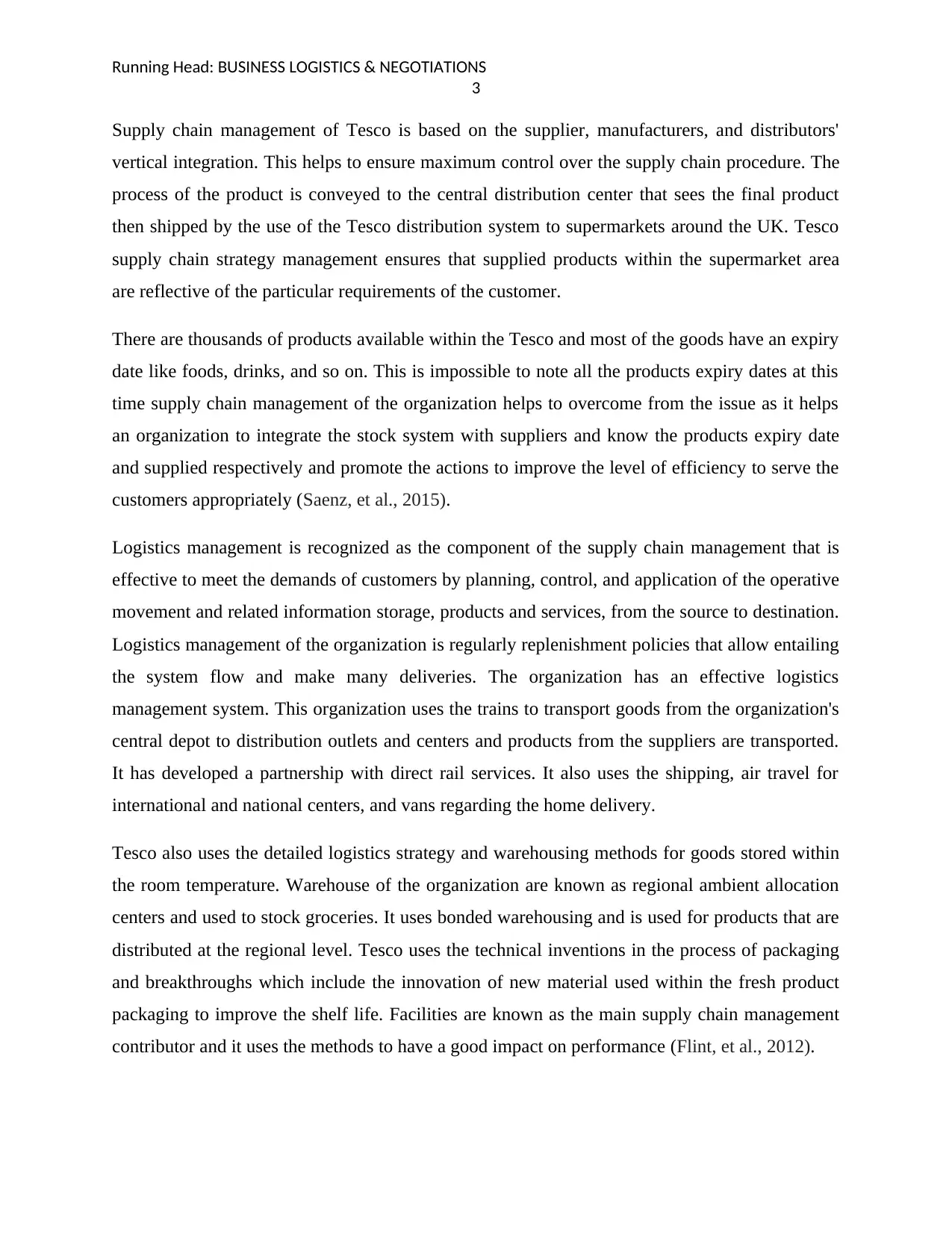
Running Head: BUSINESS LOGISTICS & NEGOTIATIONS
3
Supply chain management of Tesco is based on the supplier, manufacturers, and distributors'
vertical integration. This helps to ensure maximum control over the supply chain procedure. The
process of the product is conveyed to the central distribution center that sees the final product
then shipped by the use of the Tesco distribution system to supermarkets around the UK. Tesco
supply chain strategy management ensures that supplied products within the supermarket area
are reflective of the particular requirements of the customer.
There are thousands of products available within the Tesco and most of the goods have an expiry
date like foods, drinks, and so on. This is impossible to note all the products expiry dates at this
time supply chain management of the organization helps to overcome from the issue as it helps
an organization to integrate the stock system with suppliers and know the products expiry date
and supplied respectively and promote the actions to improve the level of efficiency to serve the
customers appropriately (Saenz, et al., 2015).
Logistics management is recognized as the component of the supply chain management that is
effective to meet the demands of customers by planning, control, and application of the operative
movement and related information storage, products and services, from the source to destination.
Logistics management of the organization is regularly replenishment policies that allow entailing
the system flow and make many deliveries. The organization has an effective logistics
management system. This organization uses the trains to transport goods from the organization's
central depot to distribution outlets and centers and products from the suppliers are transported.
It has developed a partnership with direct rail services. It also uses the shipping, air travel for
international and national centers, and vans regarding the home delivery.
Tesco also uses the detailed logistics strategy and warehousing methods for goods stored within
the room temperature. Warehouse of the organization are known as regional ambient allocation
centers and used to stock groceries. It uses bonded warehousing and is used for products that are
distributed at the regional level. Tesco uses the technical inventions in the process of packaging
and breakthroughs which include the innovation of new material used within the fresh product
packaging to improve the shelf life. Facilities are known as the main supply chain management
contributor and it uses the methods to have a good impact on performance (Flint, et al., 2012).
3
Supply chain management of Tesco is based on the supplier, manufacturers, and distributors'
vertical integration. This helps to ensure maximum control over the supply chain procedure. The
process of the product is conveyed to the central distribution center that sees the final product
then shipped by the use of the Tesco distribution system to supermarkets around the UK. Tesco
supply chain strategy management ensures that supplied products within the supermarket area
are reflective of the particular requirements of the customer.
There are thousands of products available within the Tesco and most of the goods have an expiry
date like foods, drinks, and so on. This is impossible to note all the products expiry dates at this
time supply chain management of the organization helps to overcome from the issue as it helps
an organization to integrate the stock system with suppliers and know the products expiry date
and supplied respectively and promote the actions to improve the level of efficiency to serve the
customers appropriately (Saenz, et al., 2015).
Logistics management is recognized as the component of the supply chain management that is
effective to meet the demands of customers by planning, control, and application of the operative
movement and related information storage, products and services, from the source to destination.
Logistics management of the organization is regularly replenishment policies that allow entailing
the system flow and make many deliveries. The organization has an effective logistics
management system. This organization uses the trains to transport goods from the organization's
central depot to distribution outlets and centers and products from the suppliers are transported.
It has developed a partnership with direct rail services. It also uses the shipping, air travel for
international and national centers, and vans regarding the home delivery.
Tesco also uses the detailed logistics strategy and warehousing methods for goods stored within
the room temperature. Warehouse of the organization are known as regional ambient allocation
centers and used to stock groceries. It uses bonded warehousing and is used for products that are
distributed at the regional level. Tesco uses the technical inventions in the process of packaging
and breakthroughs which include the innovation of new material used within the fresh product
packaging to improve the shelf life. Facilities are known as the main supply chain management
contributor and it uses the methods to have a good impact on performance (Flint, et al., 2012).
Paraphrase This Document
Need a fresh take? Get an instant paraphrase of this document with our AI Paraphraser
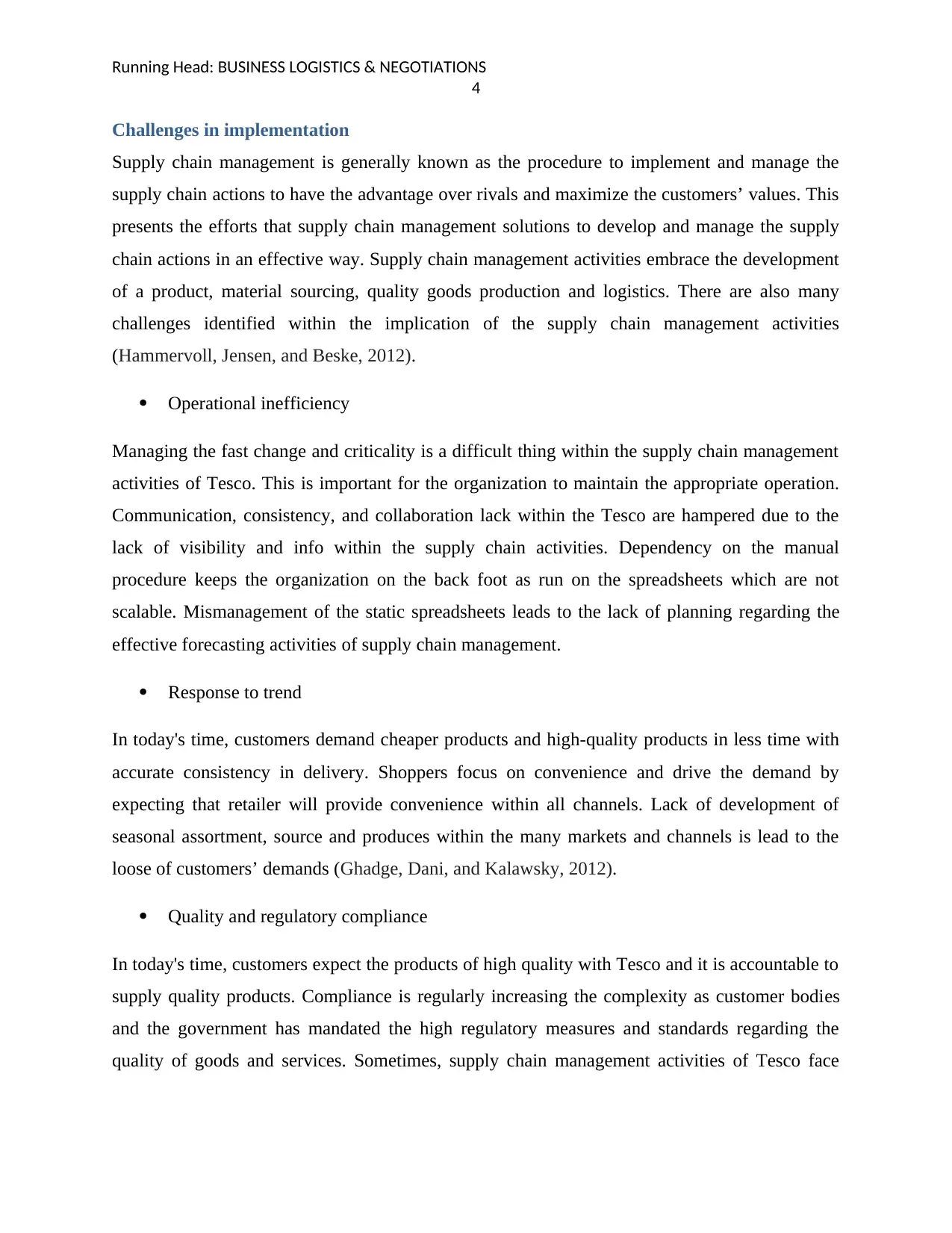
Running Head: BUSINESS LOGISTICS & NEGOTIATIONS
4
Challenges in implementation
Supply chain management is generally known as the procedure to implement and manage the
supply chain actions to have the advantage over rivals and maximize the customers’ values. This
presents the efforts that supply chain management solutions to develop and manage the supply
chain actions in an effective way. Supply chain management activities embrace the development
of a product, material sourcing, quality goods production and logistics. There are also many
challenges identified within the implication of the supply chain management activities
(Hammervoll, Jensen, and Beske, 2012).
Operational inefficiency
Managing the fast change and criticality is a difficult thing within the supply chain management
activities of Tesco. This is important for the organization to maintain the appropriate operation.
Communication, consistency, and collaboration lack within the Tesco are hampered due to the
lack of visibility and info within the supply chain activities. Dependency on the manual
procedure keeps the organization on the back foot as run on the spreadsheets which are not
scalable. Mismanagement of the static spreadsheets leads to the lack of planning regarding the
effective forecasting activities of supply chain management.
Response to trend
In today's time, customers demand cheaper products and high-quality products in less time with
accurate consistency in delivery. Shoppers focus on convenience and drive the demand by
expecting that retailer will provide convenience within all channels. Lack of development of
seasonal assortment, source and produces within the many markets and channels is lead to the
loose of customers’ demands (Ghadge, Dani, and Kalawsky, 2012).
Quality and regulatory compliance
In today's time, customers expect the products of high quality with Tesco and it is accountable to
supply quality products. Compliance is regularly increasing the complexity as customer bodies
and the government has mandated the high regulatory measures and standards regarding the
quality of goods and services. Sometimes, supply chain management activities of Tesco face
4
Challenges in implementation
Supply chain management is generally known as the procedure to implement and manage the
supply chain actions to have the advantage over rivals and maximize the customers’ values. This
presents the efforts that supply chain management solutions to develop and manage the supply
chain actions in an effective way. Supply chain management activities embrace the development
of a product, material sourcing, quality goods production and logistics. There are also many
challenges identified within the implication of the supply chain management activities
(Hammervoll, Jensen, and Beske, 2012).
Operational inefficiency
Managing the fast change and criticality is a difficult thing within the supply chain management
activities of Tesco. This is important for the organization to maintain the appropriate operation.
Communication, consistency, and collaboration lack within the Tesco are hampered due to the
lack of visibility and info within the supply chain activities. Dependency on the manual
procedure keeps the organization on the back foot as run on the spreadsheets which are not
scalable. Mismanagement of the static spreadsheets leads to the lack of planning regarding the
effective forecasting activities of supply chain management.
Response to trend
In today's time, customers demand cheaper products and high-quality products in less time with
accurate consistency in delivery. Shoppers focus on convenience and drive the demand by
expecting that retailer will provide convenience within all channels. Lack of development of
seasonal assortment, source and produces within the many markets and channels is lead to the
loose of customers’ demands (Ghadge, Dani, and Kalawsky, 2012).
Quality and regulatory compliance
In today's time, customers expect the products of high quality with Tesco and it is accountable to
supply quality products. Compliance is regularly increasing the complexity as customer bodies
and the government has mandated the high regulatory measures and standards regarding the
quality of goods and services. Sometimes, supply chain management activities of Tesco face
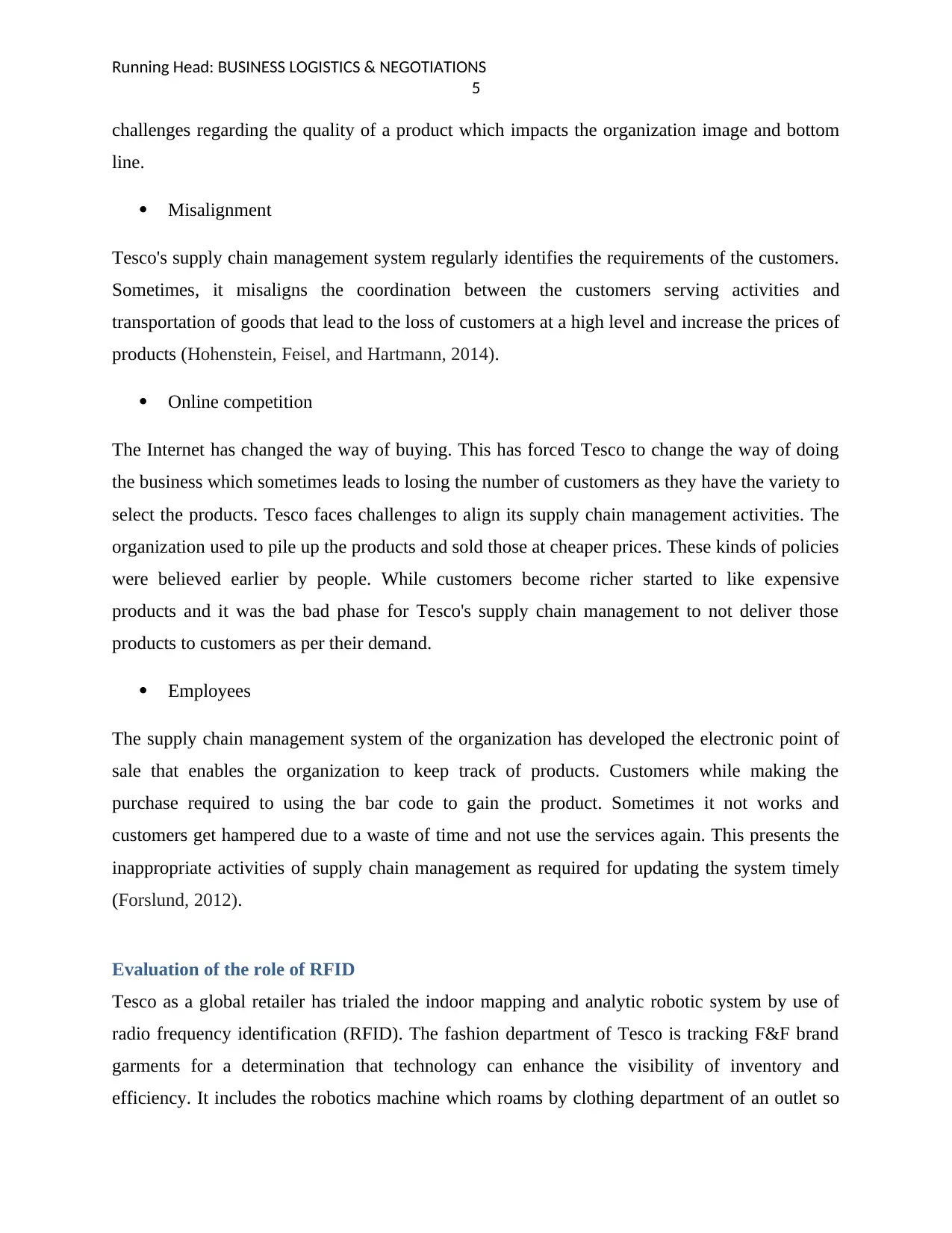
Running Head: BUSINESS LOGISTICS & NEGOTIATIONS
5
challenges regarding the quality of a product which impacts the organization image and bottom
line.
Misalignment
Tesco's supply chain management system regularly identifies the requirements of the customers.
Sometimes, it misaligns the coordination between the customers serving activities and
transportation of goods that lead to the loss of customers at a high level and increase the prices of
products (Hohenstein, Feisel, and Hartmann, 2014).
Online competition
The Internet has changed the way of buying. This has forced Tesco to change the way of doing
the business which sometimes leads to losing the number of customers as they have the variety to
select the products. Tesco faces challenges to align its supply chain management activities. The
organization used to pile up the products and sold those at cheaper prices. These kinds of policies
were believed earlier by people. While customers become richer started to like expensive
products and it was the bad phase for Tesco's supply chain management to not deliver those
products to customers as per their demand.
Employees
The supply chain management system of the organization has developed the electronic point of
sale that enables the organization to keep track of products. Customers while making the
purchase required to using the bar code to gain the product. Sometimes it not works and
customers get hampered due to a waste of time and not use the services again. This presents the
inappropriate activities of supply chain management as required for updating the system timely
(Forslund, 2012).
Evaluation of the role of RFID
Tesco as a global retailer has trialed the indoor mapping and analytic robotic system by use of
radio frequency identification (RFID). The fashion department of Tesco is tracking F&F brand
garments for a determination that technology can enhance the visibility of inventory and
efficiency. It includes the robotics machine which roams by clothing department of an outlet so
5
challenges regarding the quality of a product which impacts the organization image and bottom
line.
Misalignment
Tesco's supply chain management system regularly identifies the requirements of the customers.
Sometimes, it misaligns the coordination between the customers serving activities and
transportation of goods that lead to the loss of customers at a high level and increase the prices of
products (Hohenstein, Feisel, and Hartmann, 2014).
Online competition
The Internet has changed the way of buying. This has forced Tesco to change the way of doing
the business which sometimes leads to losing the number of customers as they have the variety to
select the products. Tesco faces challenges to align its supply chain management activities. The
organization used to pile up the products and sold those at cheaper prices. These kinds of policies
were believed earlier by people. While customers become richer started to like expensive
products and it was the bad phase for Tesco's supply chain management to not deliver those
products to customers as per their demand.
Employees
The supply chain management system of the organization has developed the electronic point of
sale that enables the organization to keep track of products. Customers while making the
purchase required to using the bar code to gain the product. Sometimes it not works and
customers get hampered due to a waste of time and not use the services again. This presents the
inappropriate activities of supply chain management as required for updating the system timely
(Forslund, 2012).
Evaluation of the role of RFID
Tesco as a global retailer has trialed the indoor mapping and analytic robotic system by use of
radio frequency identification (RFID). The fashion department of Tesco is tracking F&F brand
garments for a determination that technology can enhance the visibility of inventory and
efficiency. It includes the robotics machine which roams by clothing department of an outlet so
⊘ This is a preview!⊘
Do you want full access?
Subscribe today to unlock all pages.

Trusted by 1+ million students worldwide
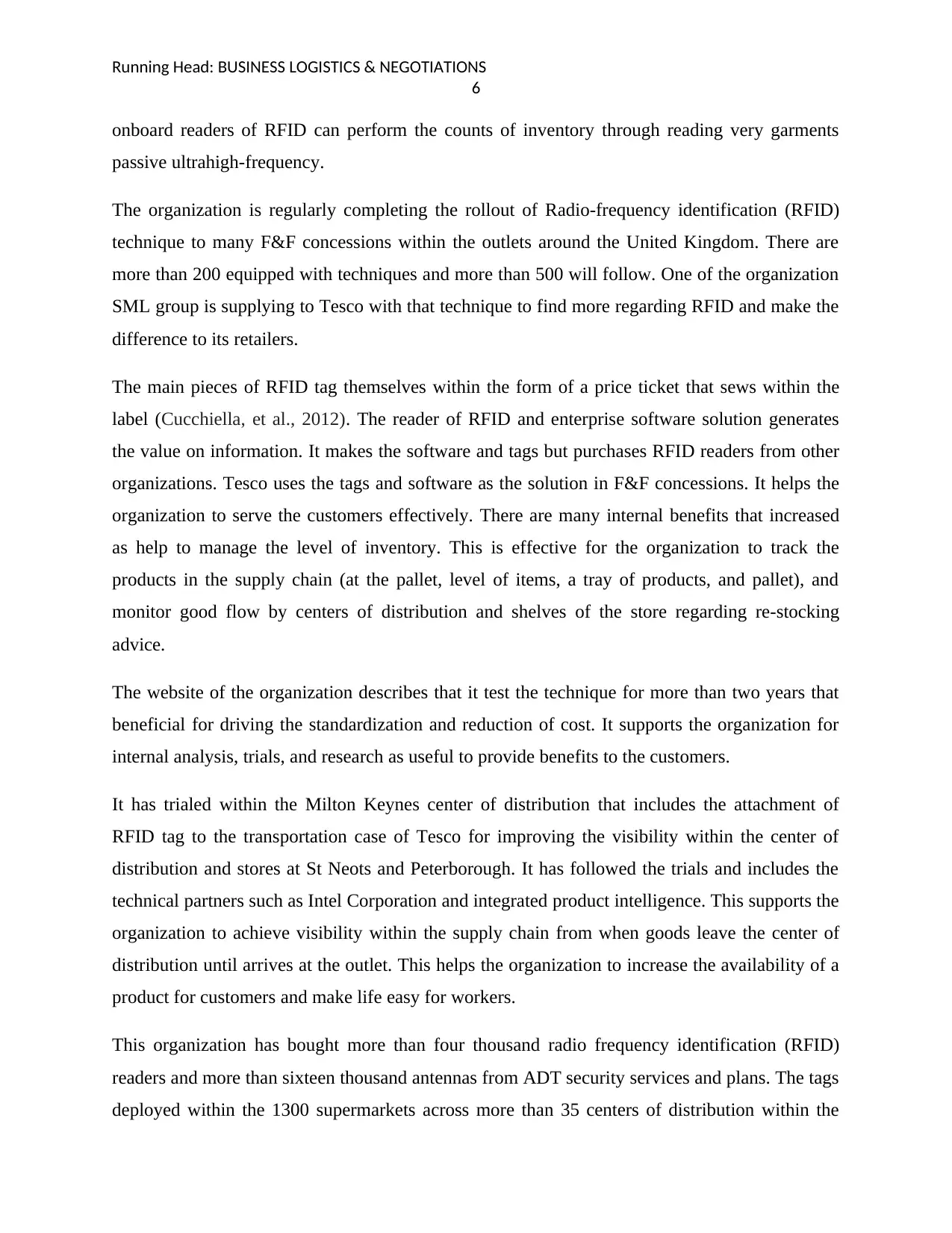
Running Head: BUSINESS LOGISTICS & NEGOTIATIONS
6
onboard readers of RFID can perform the counts of inventory through reading very garments
passive ultrahigh-frequency.
The organization is regularly completing the rollout of Radio-frequency identification (RFID)
technique to many F&F concessions within the outlets around the United Kingdom. There are
more than 200 equipped with techniques and more than 500 will follow. One of the organization
SML group is supplying to Tesco with that technique to find more regarding RFID and make the
difference to its retailers.
The main pieces of RFID tag themselves within the form of a price ticket that sews within the
label (Cucchiella, et al., 2012). The reader of RFID and enterprise software solution generates
the value on information. It makes the software and tags but purchases RFID readers from other
organizations. Tesco uses the tags and software as the solution in F&F concessions. It helps the
organization to serve the customers effectively. There are many internal benefits that increased
as help to manage the level of inventory. This is effective for the organization to track the
products in the supply chain (at the pallet, level of items, a tray of products, and pallet), and
monitor good flow by centers of distribution and shelves of the store regarding re-stocking
advice.
The website of the organization describes that it test the technique for more than two years that
beneficial for driving the standardization and reduction of cost. It supports the organization for
internal analysis, trials, and research as useful to provide benefits to the customers.
It has trialed within the Milton Keynes center of distribution that includes the attachment of
RFID tag to the transportation case of Tesco for improving the visibility within the center of
distribution and stores at St Neots and Peterborough. It has followed the trials and includes the
technical partners such as Intel Corporation and integrated product intelligence. This supports the
organization to achieve visibility within the supply chain from when goods leave the center of
distribution until arrives at the outlet. This helps the organization to increase the availability of a
product for customers and make life easy for workers.
This organization has bought more than four thousand radio frequency identification (RFID)
readers and more than sixteen thousand antennas from ADT security services and plans. The tags
deployed within the 1300 supermarkets across more than 35 centers of distribution within the
6
onboard readers of RFID can perform the counts of inventory through reading very garments
passive ultrahigh-frequency.
The organization is regularly completing the rollout of Radio-frequency identification (RFID)
technique to many F&F concessions within the outlets around the United Kingdom. There are
more than 200 equipped with techniques and more than 500 will follow. One of the organization
SML group is supplying to Tesco with that technique to find more regarding RFID and make the
difference to its retailers.
The main pieces of RFID tag themselves within the form of a price ticket that sews within the
label (Cucchiella, et al., 2012). The reader of RFID and enterprise software solution generates
the value on information. It makes the software and tags but purchases RFID readers from other
organizations. Tesco uses the tags and software as the solution in F&F concessions. It helps the
organization to serve the customers effectively. There are many internal benefits that increased
as help to manage the level of inventory. This is effective for the organization to track the
products in the supply chain (at the pallet, level of items, a tray of products, and pallet), and
monitor good flow by centers of distribution and shelves of the store regarding re-stocking
advice.
The website of the organization describes that it test the technique for more than two years that
beneficial for driving the standardization and reduction of cost. It supports the organization for
internal analysis, trials, and research as useful to provide benefits to the customers.
It has trialed within the Milton Keynes center of distribution that includes the attachment of
RFID tag to the transportation case of Tesco for improving the visibility within the center of
distribution and stores at St Neots and Peterborough. It has followed the trials and includes the
technical partners such as Intel Corporation and integrated product intelligence. This supports the
organization to achieve visibility within the supply chain from when goods leave the center of
distribution until arrives at the outlet. This helps the organization to increase the availability of a
product for customers and make life easy for workers.
This organization has bought more than four thousand radio frequency identification (RFID)
readers and more than sixteen thousand antennas from ADT security services and plans. The tags
deployed within the 1300 supermarkets across more than 35 centers of distribution within the
Paraphrase This Document
Need a fresh take? Get an instant paraphrase of this document with our AI Paraphraser
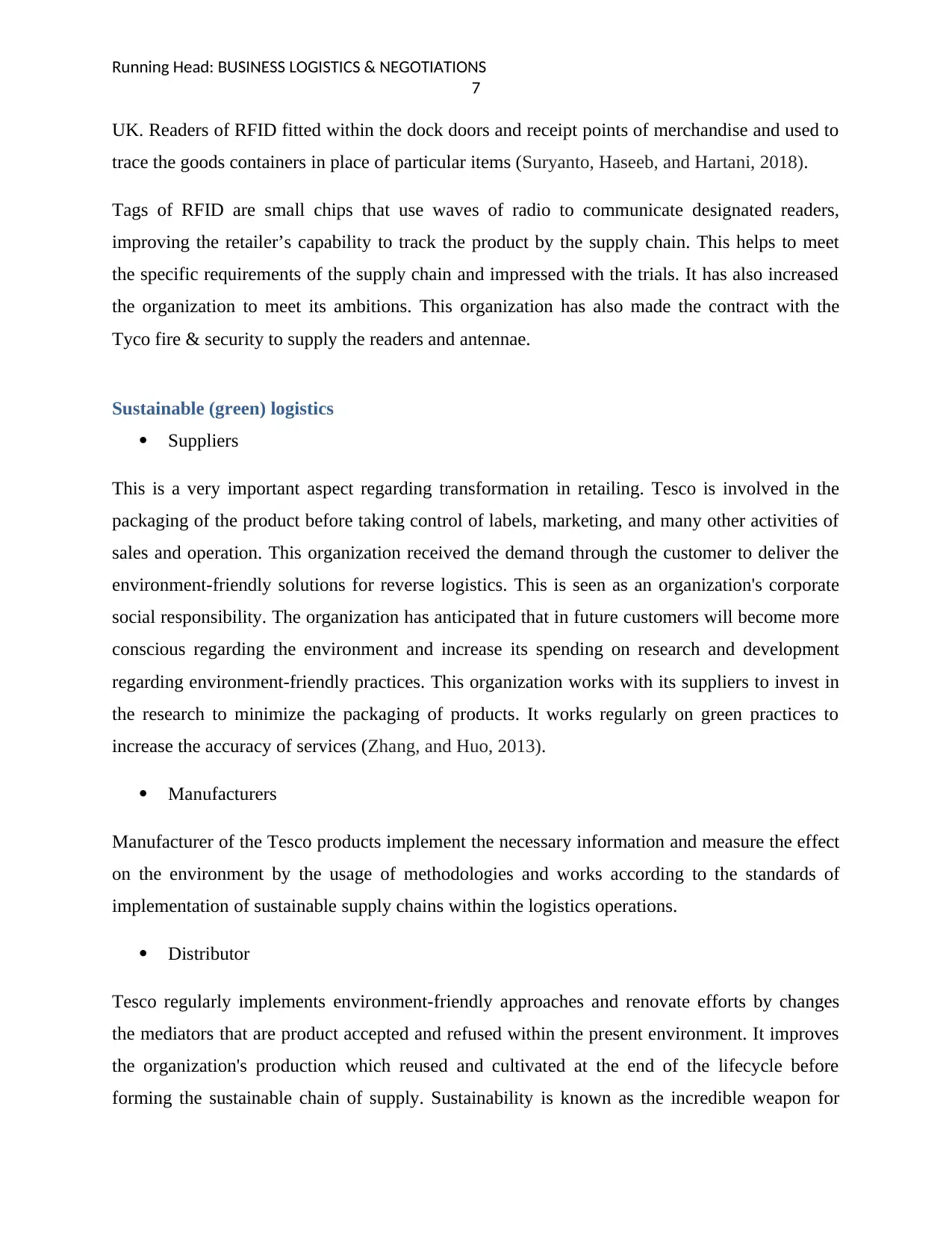
Running Head: BUSINESS LOGISTICS & NEGOTIATIONS
7
UK. Readers of RFID fitted within the dock doors and receipt points of merchandise and used to
trace the goods containers in place of particular items (Suryanto, Haseeb, and Hartani, 2018).
Tags of RFID are small chips that use waves of radio to communicate designated readers,
improving the retailer’s capability to track the product by the supply chain. This helps to meet
the specific requirements of the supply chain and impressed with the trials. It has also increased
the organization to meet its ambitions. This organization has also made the contract with the
Tyco fire & security to supply the readers and antennae.
Sustainable (green) logistics
Suppliers
This is a very important aspect regarding transformation in retailing. Tesco is involved in the
packaging of the product before taking control of labels, marketing, and many other activities of
sales and operation. This organization received the demand through the customer to deliver the
environment-friendly solutions for reverse logistics. This is seen as an organization's corporate
social responsibility. The organization has anticipated that in future customers will become more
conscious regarding the environment and increase its spending on research and development
regarding environment-friendly practices. This organization works with its suppliers to invest in
the research to minimize the packaging of products. It works regularly on green practices to
increase the accuracy of services (Zhang, and Huo, 2013).
Manufacturers
Manufacturer of the Tesco products implement the necessary information and measure the effect
on the environment by the usage of methodologies and works according to the standards of
implementation of sustainable supply chains within the logistics operations.
Distributor
Tesco regularly implements environment-friendly approaches and renovate efforts by changes
the mediators that are product accepted and refused within the present environment. It improves
the organization's production which reused and cultivated at the end of the lifecycle before
forming the sustainable chain of supply. Sustainability is known as the incredible weapon for
7
UK. Readers of RFID fitted within the dock doors and receipt points of merchandise and used to
trace the goods containers in place of particular items (Suryanto, Haseeb, and Hartani, 2018).
Tags of RFID are small chips that use waves of radio to communicate designated readers,
improving the retailer’s capability to track the product by the supply chain. This helps to meet
the specific requirements of the supply chain and impressed with the trials. It has also increased
the organization to meet its ambitions. This organization has also made the contract with the
Tyco fire & security to supply the readers and antennae.
Sustainable (green) logistics
Suppliers
This is a very important aspect regarding transformation in retailing. Tesco is involved in the
packaging of the product before taking control of labels, marketing, and many other activities of
sales and operation. This organization received the demand through the customer to deliver the
environment-friendly solutions for reverse logistics. This is seen as an organization's corporate
social responsibility. The organization has anticipated that in future customers will become more
conscious regarding the environment and increase its spending on research and development
regarding environment-friendly practices. This organization works with its suppliers to invest in
the research to minimize the packaging of products. It works regularly on green practices to
increase the accuracy of services (Zhang, and Huo, 2013).
Manufacturers
Manufacturer of the Tesco products implement the necessary information and measure the effect
on the environment by the usage of methodologies and works according to the standards of
implementation of sustainable supply chains within the logistics operations.
Distributor
Tesco regularly implements environment-friendly approaches and renovate efforts by changes
the mediators that are product accepted and refused within the present environment. It improves
the organization's production which reused and cultivated at the end of the lifecycle before
forming the sustainable chain of supply. Sustainability is known as the incredible weapon for
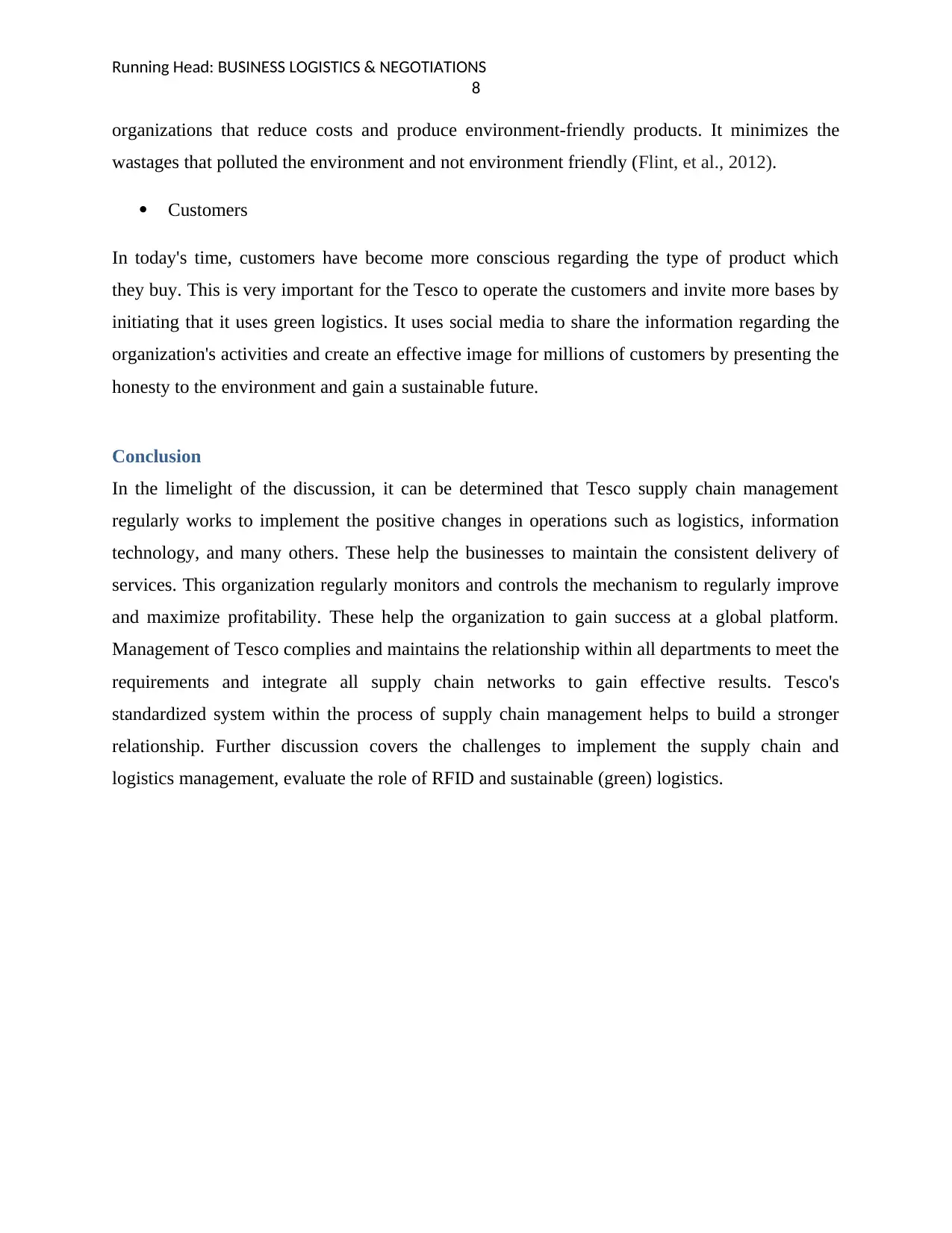
Running Head: BUSINESS LOGISTICS & NEGOTIATIONS
8
organizations that reduce costs and produce environment-friendly products. It minimizes the
wastages that polluted the environment and not environment friendly (Flint, et al., 2012).
Customers
In today's time, customers have become more conscious regarding the type of product which
they buy. This is very important for the Tesco to operate the customers and invite more bases by
initiating that it uses green logistics. It uses social media to share the information regarding the
organization's activities and create an effective image for millions of customers by presenting the
honesty to the environment and gain a sustainable future.
Conclusion
In the limelight of the discussion, it can be determined that Tesco supply chain management
regularly works to implement the positive changes in operations such as logistics, information
technology, and many others. These help the businesses to maintain the consistent delivery of
services. This organization regularly monitors and controls the mechanism to regularly improve
and maximize profitability. These help the organization to gain success at a global platform.
Management of Tesco complies and maintains the relationship within all departments to meet the
requirements and integrate all supply chain networks to gain effective results. Tesco's
standardized system within the process of supply chain management helps to build a stronger
relationship. Further discussion covers the challenges to implement the supply chain and
logistics management, evaluate the role of RFID and sustainable (green) logistics.
8
organizations that reduce costs and produce environment-friendly products. It minimizes the
wastages that polluted the environment and not environment friendly (Flint, et al., 2012).
Customers
In today's time, customers have become more conscious regarding the type of product which
they buy. This is very important for the Tesco to operate the customers and invite more bases by
initiating that it uses green logistics. It uses social media to share the information regarding the
organization's activities and create an effective image for millions of customers by presenting the
honesty to the environment and gain a sustainable future.
Conclusion
In the limelight of the discussion, it can be determined that Tesco supply chain management
regularly works to implement the positive changes in operations such as logistics, information
technology, and many others. These help the businesses to maintain the consistent delivery of
services. This organization regularly monitors and controls the mechanism to regularly improve
and maximize profitability. These help the organization to gain success at a global platform.
Management of Tesco complies and maintains the relationship within all departments to meet the
requirements and integrate all supply chain networks to gain effective results. Tesco's
standardized system within the process of supply chain management helps to build a stronger
relationship. Further discussion covers the challenges to implement the supply chain and
logistics management, evaluate the role of RFID and sustainable (green) logistics.
⊘ This is a preview!⊘
Do you want full access?
Subscribe today to unlock all pages.

Trusted by 1+ million students worldwide
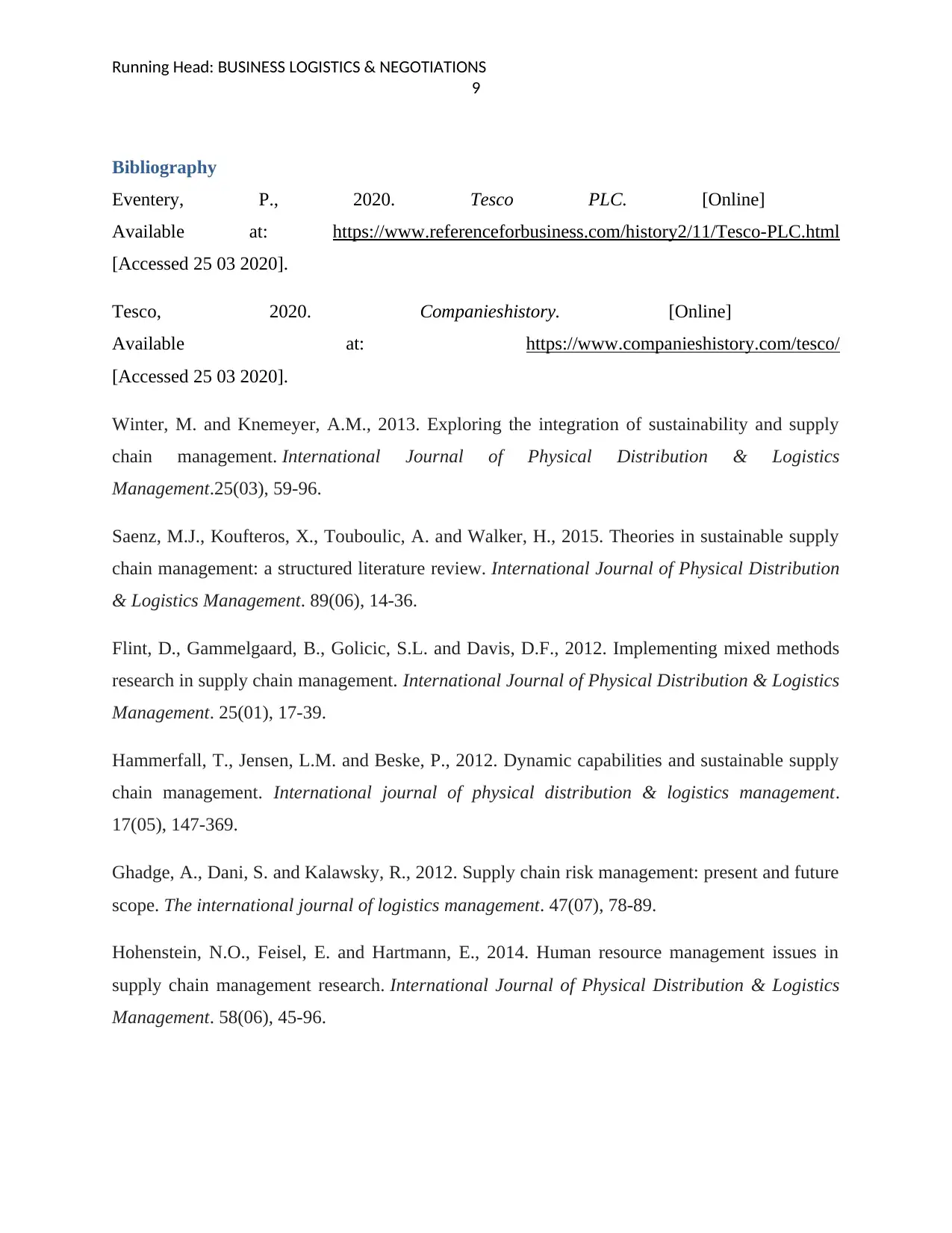
Running Head: BUSINESS LOGISTICS & NEGOTIATIONS
9
Bibliography
Eventery, P., 2020. Tesco PLC. [Online]
Available at: https://www.referenceforbusiness.com/history2/11/Tesco-PLC.html
[Accessed 25 03 2020].
Tesco, 2020. Companieshistory. [Online]
Available at: https://www.companieshistory.com/tesco/
[Accessed 25 03 2020].
Winter, M. and Knemeyer, A.M., 2013. Exploring the integration of sustainability and supply
chain management. International Journal of Physical Distribution & Logistics
Management.25(03), 59-96.
Saenz, M.J., Koufteros, X., Touboulic, A. and Walker, H., 2015. Theories in sustainable supply
chain management: a structured literature review. International Journal of Physical Distribution
& Logistics Management. 89(06), 14-36.
Flint, D., Gammelgaard, B., Golicic, S.L. and Davis, D.F., 2012. Implementing mixed methods
research in supply chain management. International Journal of Physical Distribution & Logistics
Management. 25(01), 17-39.
Hammerfall, T., Jensen, L.M. and Beske, P., 2012. Dynamic capabilities and sustainable supply
chain management. International journal of physical distribution & logistics management.
17(05), 147-369.
Ghadge, A., Dani, S. and Kalawsky, R., 2012. Supply chain risk management: present and future
scope. The international journal of logistics management. 47(07), 78-89.
Hohenstein, N.O., Feisel, E. and Hartmann, E., 2014. Human resource management issues in
supply chain management research. International Journal of Physical Distribution & Logistics
Management. 58(06), 45-96.
9
Bibliography
Eventery, P., 2020. Tesco PLC. [Online]
Available at: https://www.referenceforbusiness.com/history2/11/Tesco-PLC.html
[Accessed 25 03 2020].
Tesco, 2020. Companieshistory. [Online]
Available at: https://www.companieshistory.com/tesco/
[Accessed 25 03 2020].
Winter, M. and Knemeyer, A.M., 2013. Exploring the integration of sustainability and supply
chain management. International Journal of Physical Distribution & Logistics
Management.25(03), 59-96.
Saenz, M.J., Koufteros, X., Touboulic, A. and Walker, H., 2015. Theories in sustainable supply
chain management: a structured literature review. International Journal of Physical Distribution
& Logistics Management. 89(06), 14-36.
Flint, D., Gammelgaard, B., Golicic, S.L. and Davis, D.F., 2012. Implementing mixed methods
research in supply chain management. International Journal of Physical Distribution & Logistics
Management. 25(01), 17-39.
Hammerfall, T., Jensen, L.M. and Beske, P., 2012. Dynamic capabilities and sustainable supply
chain management. International journal of physical distribution & logistics management.
17(05), 147-369.
Ghadge, A., Dani, S. and Kalawsky, R., 2012. Supply chain risk management: present and future
scope. The international journal of logistics management. 47(07), 78-89.
Hohenstein, N.O., Feisel, E. and Hartmann, E., 2014. Human resource management issues in
supply chain management research. International Journal of Physical Distribution & Logistics
Management. 58(06), 45-96.
Paraphrase This Document
Need a fresh take? Get an instant paraphrase of this document with our AI Paraphraser
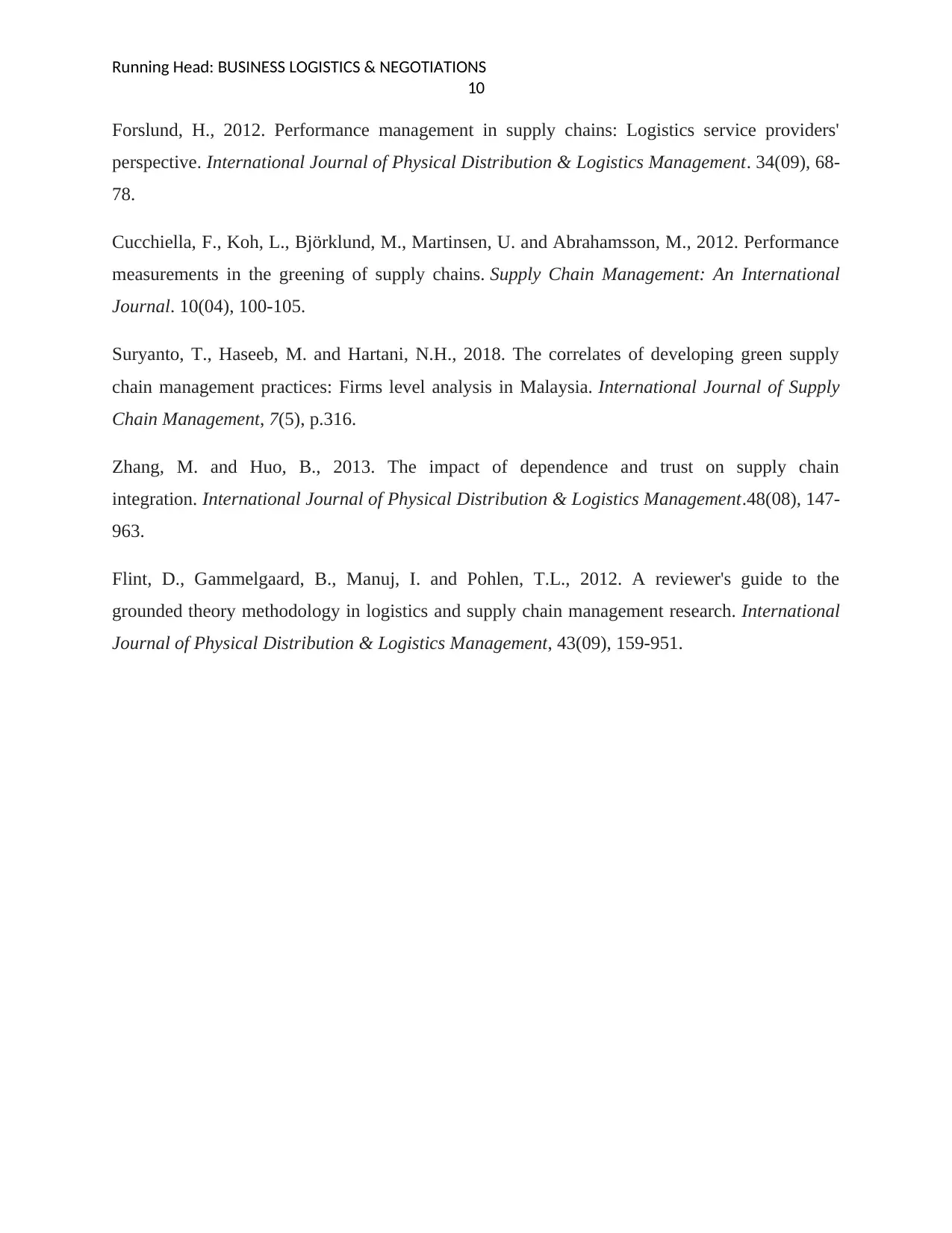
Running Head: BUSINESS LOGISTICS & NEGOTIATIONS
10
Forslund, H., 2012. Performance management in supply chains: Logistics service providers'
perspective. International Journal of Physical Distribution & Logistics Management. 34(09), 68-
78.
Cucchiella, F., Koh, L., Björklund, M., Martinsen, U. and Abrahamsson, M., 2012. Performance
measurements in the greening of supply chains. Supply Chain Management: An International
Journal. 10(04), 100-105.
Suryanto, T., Haseeb, M. and Hartani, N.H., 2018. The correlates of developing green supply
chain management practices: Firms level analysis in Malaysia. International Journal of Supply
Chain Management, 7(5), p.316.
Zhang, M. and Huo, B., 2013. The impact of dependence and trust on supply chain
integration. International Journal of Physical Distribution & Logistics Management.48(08), 147-
963.
Flint, D., Gammelgaard, B., Manuj, I. and Pohlen, T.L., 2012. A reviewer's guide to the
grounded theory methodology in logistics and supply chain management research. International
Journal of Physical Distribution & Logistics Management, 43(09), 159-951.
10
Forslund, H., 2012. Performance management in supply chains: Logistics service providers'
perspective. International Journal of Physical Distribution & Logistics Management. 34(09), 68-
78.
Cucchiella, F., Koh, L., Björklund, M., Martinsen, U. and Abrahamsson, M., 2012. Performance
measurements in the greening of supply chains. Supply Chain Management: An International
Journal. 10(04), 100-105.
Suryanto, T., Haseeb, M. and Hartani, N.H., 2018. The correlates of developing green supply
chain management practices: Firms level analysis in Malaysia. International Journal of Supply
Chain Management, 7(5), p.316.
Zhang, M. and Huo, B., 2013. The impact of dependence and trust on supply chain
integration. International Journal of Physical Distribution & Logistics Management.48(08), 147-
963.
Flint, D., Gammelgaard, B., Manuj, I. and Pohlen, T.L., 2012. A reviewer's guide to the
grounded theory methodology in logistics and supply chain management research. International
Journal of Physical Distribution & Logistics Management, 43(09), 159-951.
1 out of 11
Related Documents
Your All-in-One AI-Powered Toolkit for Academic Success.
+13062052269
info@desklib.com
Available 24*7 on WhatsApp / Email
![[object Object]](/_next/static/media/star-bottom.7253800d.svg)
Unlock your academic potential
Copyright © 2020–2025 A2Z Services. All Rights Reserved. Developed and managed by ZUCOL.





